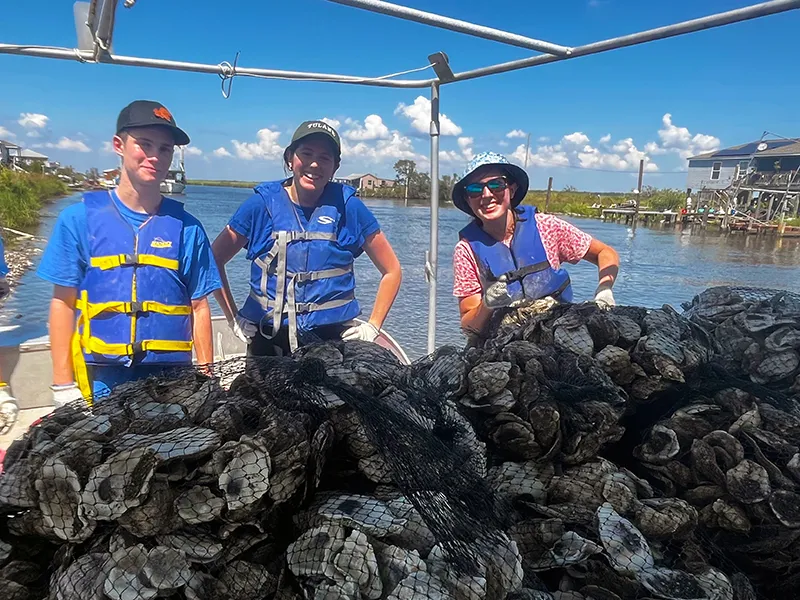
On a clear, hot morning in late September, freshmen from Adjunct Professor Laura Kelley’s class "Indian Tribes On the Bayou” (Honors Colloquium COLQ 1020-07) boarded a bus headed to the Southeastern tip of Louisiana, where an endless network of bayous and tributaries weave their way into the Gulf of Mexico.
Upon arriving in Port Sulphur, Louisiana, Tulane students and faculty joined volunteers from the Coalition to Restore Coastal Louisiana (CRCL). Together, they moved hundreds of bags of oyster shells into small fishing boats to make the short trip to Grand Bayou Indian Village, home of the Atakapa-Ishak/Chawasha Tribe.
Freshman Kali Lasseigne, who grew up exploring the swamps and bayous of Berwick, Louisiana, immediately noticed something off about this landscape. Exposed roots from erosion and dead trees made the land look almost desert-like. Most notably, “the marsh had big dents in it, as if someone took a bite out of the land,” she explains.
Once stacked together, the bags of oyster shells — products of CRCL’s decade-long recycling program — mimic natural oyster reefs, fighting back against coastal erosion and helping to prevent the “bites” that Kali observed. In Grand Bayou Indian Village, the assembly line started up again, with help from Atakapa-Ishak/Chawasha tribal members, unloading the oyster bags to stack along the shoreline. Several students even jumped in the water, getting thigh-high in the marsh, to lay down the first layer of bags. Professor Kelley noted how, in nearby Pointe-au-Chien Indian Tribe’s land, she has seen CRCL bags in action, where even after sustaining damage from Hurricane Ida, the reefs were doing what they were meant to do, protect the land. Over time, she explains, “they become almost cement-like. And then baby oysters grow on top of them, so it becomes like a living reef.”
Oyster reefs not only offer storm protection but create habitats for marine life like fish, crabs, and shorebirds. Plus, a single oyster filters up to fifty gallons of water a day, contributing to a healthier gulf while growing nutritious, regenerative food. “Oysters are really the perfect biomaterial,” says Saanvi Nair, a freshman who plans to major in cell molecular biology.
Students like Saanvi and Kali, both on a pre-med track, recognized the benefit of the anthropological (and interdisciplinary) approach of the course. Tribes like the Atakapa-Ishak/Chawasha and the Pointe-au-Chien face interconnected challenges — coastal erosion, overfishing, the after-effects of exploitative mining and oil drilling, man-made and natural disasters — that cannot be siloed into single disciplines. By engaging directly with the people affected, the course creates a holistic framework for understanding complex issues at play. For someone interested in medicine and molecular biology, Saanvi gained perspective on issues of health equity while exploring the connection between history and health.
And the journey out to Grand Bayou Indian Village gave her a much-needed context. “Seeing coastal erosion first-hand and seeing how it affects actual people makes it a lot more tangible,” she shared. “And you just feel more connected to the cause.”
Throughout the rest of the semester, Kelley’s class partners with the Pointe-au-Chien Indian Tribe, designing projects around their needs. This semester, Kelley’s class wrote a French-English children’s book, focusing on the history and culture of fishing and food, that will get published and used at Pointe-au-Chien’s new French-Indigenous immersion school, Ecole Pointe-au-Chien.
“One of my favorite aspects of Native culture (so far) is the idea of stewardship of the land,” shared Kali. “Every Native culture we have learned about — and there have been many — has respected, loved, and tended to the land in a way we simply do not see today.”
Grand Bayou Indian Village sits at the edge of the gulf, one of the only tribal communities accessible exclusively by water. The Tribe first raised their houses when Hurricane Katrina floodwater reached an unprecedented 10 feet; it is now an entire floating village, stilted above the water.
Like the mighty oyster itself, the reciprocal benefits of this small project were manyfold. Oyster bags help preserve an important cultural and historic site.
And, as Kelley points out, with recent storms Helene and Milton fresh on everyone’s mind, “The problems on these frontline communities are not just a problem of Pointe-au-Chien, and not just a problem of Grand Bayou Indian Village and others — it’s an everybody problem, right?”
“If we don't work together as a community and deal with these things then we're going to get nowhere fast,” Kelley goes on.
“We get a lot of negative news, and it feels very depressing, like we can't do anything about climate change and all the associated problems with it,” Kelley adds. “And then you do something like this, and you think, if we all just did something in our backyard, that little something in all of our backyards amounts to a whole lot of something.”
Service learning is a requirement for all Tulane students, and the Center for Public Service (CPS) works to cultivate lasting, mutually beneficial relationships with CRCL and other community organizations, allowing professors like Kelley to build community engagement into their courses in such innovative ways.
“Of course, this class has made me want to volunteer more,” Kali shared. “Not only do I get to connect with my roots, I get to be a part of something larger than myself, and who wouldn’t want more of that?”
Anyone is welcome to volunteer with CRCL, but as Kelley points out, there’s an even simpler way to help: eat oysters. About 35 restaurants in New Orleans participate in CRCL’s oyster shell recycling project, and by dining there, patrons help return shells to the Gulf to build reefs and breathe life back into the coastline — a win-win for everyone.

